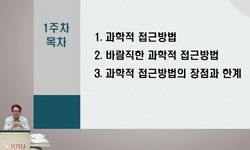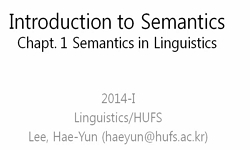This study attempts to characterize how the meaning of a word may undergo change or generate various meamings in contexts, but still retain some features or vestige of its original meaning. For instance, man, which means a general person in the lexico...
http://chineseinput.net/에서 pinyin(병음)방식으로 중국어를 변환할 수 있습니다.
변환된 중국어를 복사하여 사용하시면 됩니다.
- 中文 을 입력하시려면 zhongwen을 입력하시고 space를누르시면됩니다.
- 北京 을 입력하시려면 beijing을 입력하시고 space를 누르시면 됩니다.
부가정보
다국어 초록 (Multilingual Abstract)
The polysemical use of a word comes from association; we associate cattle with cow, bull, horn, rumination, slow, dull, etc., as exemplified in Tom's cattle are bullfighters, My reminiscence of her is always of cattle, or You are cattle! The field of association is a device for generating meaning. Compounding or making phrases or wordgroups, is another device for it, e. g., lion-hunting, blood-let, kill-joy, dark-blue, whitewash, noble man, take part in, a very pretty girl, his safe arrival. These devices make it possible for us to generate countless meanings with a small number of symbols(words).
Therefore, it is assumed here that some words have a more powerful generative capacity than others, because they are basic in terms of structural importance, i. e., semantic field and frequency. C. K. Ogden's Basic English, which is widely regarded as basic in this sense, is used as the source materials for this study. And in redefining or rephrasing, I selected 142 words as sememes from his 850 vocabulary items, and then tested their reproductive (generative) capacity by using the 142 words.
This study attempts to characterize how the meaning of a word may undergo change or generate various meamings in contexts, but still retain some features or vestige of its original meaning. For instance, man, which means a general person in the lexicon, has become specialized as paraphrased in the following classical examples: My man (=husband) is not at home. They are the King's men (=servants), He is an Oxfordman(=student). Or a word may acquire a figurative meaning as man in She is a man (=manly), eye in the eye of a needle, or hand in the hands of a clock. Thus primary meaning is taken here as the material with which the various peripheral meanings are generated, either connotatively or denotatively. For example, deer, whose meaning has been tremendously specialized, since Old English times, still retains the meaning 'animateness', the various tables in the contexts such as the table for breakfast, the time table, and the table of contents have the meaning 'flatness'.
The polysemical use of a word comes from association; we associate cattle with cow, bull, horn, rumination, slow, dull, etc., as exemplified in Tom's cattle are bullfighters, My reminiscence of her is always of cattle, or You are cattle! The field of association is a device for generating meaning. Compounding or making phrases or wordgroups, is another device for it, e. g., lion-hunting, blood-let, kill-joy, dark-blue, whitewash, noble man, take part in, a very pretty girl, his safe arrival. These devices make it possible for us to generate countless meanings with a small number of symbols(words).
Therefore, it is assumed here that some words have a more powerful generative capacity than others, because they are basic in terms of structural importance, i. e., semantic field and frequency. C. K. Ogden's Basic English, which is widely regarded as basic in this sense, is used as the source materials for this study. And in redefining or rephrasing, I selected 142 words as sememes from his 850 vocabulary items, and then tested their reproductive (generative) capacity by using the 142 words.
목차 (Table of Contents)
- Ⅰ. 序論
- Ⅱ. 意味의 定義
- Ⅲ. 意味의 두 類型
- Ⅳ. 意味의 生成
- Ⅴ. 意味生成의 實際
- Ⅰ. 序論
- Ⅱ. 意味의 定義
- Ⅲ. 意味의 두 類型
- Ⅳ. 意味의 生成
- Ⅴ. 意味生成의 實際
- Ⅵ. 結論
동일학술지(권/호) 다른 논문
-
Mark Twiain Huckleberry Finn과J. D, Salinger의 holden Caulfield의 Human Figure에 對한 比較 硏究
- 충남대학교 인문과학연구소
- 朴相用
- 1975
- KCI등재
-
- 충남대학교 인문과학연구소
- 崔元圭
- 1975
- KCI등재
-
SURVEY OF SCHOLARSHIP AND CRITICISM ON PAMELA
- 충남대학교 인문과학연구소
- Youn, Kee-Han
- 1975
- KCI등재





 RISS
RISS







